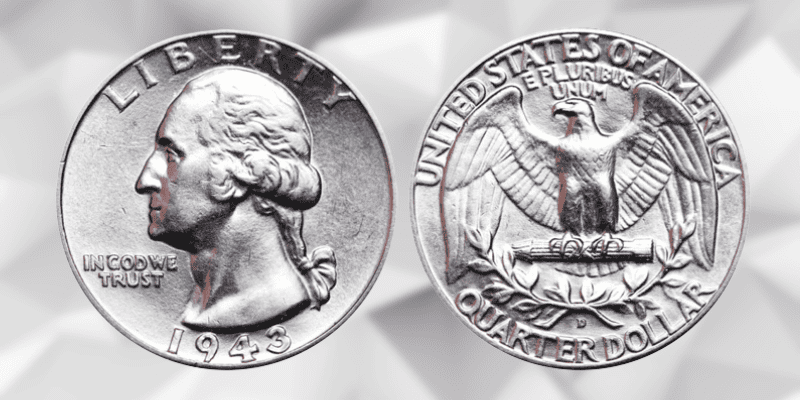A Personal Journey into Coin Collecting
Let me take you on a journey through time, back to 1943 – a year that transformed not just American history, but the very metal in your pocket. As a collector who‘s spent decades chasing the stories behind each coin, I‘ve learned that every quarter tells a tale far richer than its face value.
The Whispers of Wartime Metal
Imagine a time when every piece of metal counted. World War II wasn‘t just a conflict fought on distant shores – it was a battle that reached into the pockets of every American. The 1943 quarter represents more than currency; it‘s a metallic snapshot of national resilience.
When I first held a 1943 quarter, I could feel the weight of history. The coin wasn‘t just silver and copper – it was a testament to American industry, sacrifice, and innovation during one of the most challenging periods of the 20th century.
The Metallurgical Marvel of 1943
The composition of the 1943 quarter tells a fascinating story of wartime resourcefulness. Containing 90% silver and 10% copper, these coins were more than monetary instruments – they were strategic resources. The United States Mint faced unprecedented challenges, balancing national defense needs with currency production.
Minting Under Pressure
Each of the three mints – Philadelphia, Denver, and San Francisco – operated under extraordinary circumstances. The Philadelphia mint, producing the largest volume at 99,700,000 coins, became a critical hub of wartime production. Denver and San Francisco followed suit, with 16,095,600 and 21,700,000 coins respectively.
Decoding the Value: More Than Just Silver
Understanding the value of a 1943 quarter requires more than a simple glance at current market prices. It demands a nuanced approach that considers multiple factors:
Condition is King
In the world of numismatics, condition reigns supreme. A pristine 1943 quarter can transform from a \$5 piece of circulated history to a \$25,000 collector‘s treasure. The difference lies in microscopic details – subtle wear, mint luster, and preservation quality.
Mint Marks: The Subtle Differentiators
Not all 1943 quarters are created equal. The mint mark becomes a critical identifier of potential value. A Philadelphia quarter (no mint mark) might seem ordinary, but certain variations can make collectors‘ hearts race.
The Thrill of Error Coins
Some of the most valuable 1943 quarters aren‘t perfect – they‘re beautifully flawed. Doubled die varieties, especially from the Philadelphia and San Francisco mints, can command extraordinary prices. I‘ve seen collectors spend years hunting a single rare error coin, their passion driving them beyond mere monetary value.
Hunting the Rare Varieties
The 1943 Doubled Die Obverse is a prime example. What might look like a minor imperfection to an untrained eye can represent thousands of dollars to a serious collector. These coins aren‘t just metal – they‘re historical artifacts with stories etched into every microscopic detail.
Investment Potential: Beyond Collectibility
While passion drives many collectors, the 1943 quarter also represents a fascinating investment opportunity. The silver content alone provides a baseline value, but exceptional specimens can appreciate dramatically.
Market Dynamics
Recent auction records demonstrate the potential. A pristine MS-68 graded 1943 quarter has sold for as much as \$23,000 – a remarkable return for a coin that once circulated for just 25 cents.
Preservation: Protecting Historical Treasures
As a collector, I cannot stress enough the importance of proper preservation. Humidity, handling, and storage can make the difference between a valuable collectible and a forgotten piece of metal.
Expert Preservation Tips
- Use non-reactive, acid-free holders
- Minimize direct handling
- Control environmental conditions
- Consider professional grading
The Human Connection
Beyond numbers and grades, coin collecting is about connection. Each 1943 quarter carries the energy of a nation at war – of workers in mints, soldiers abroad, and families waiting at home.
A Living History
When you hold a 1943 quarter, you‘re not just holding a coin. You‘re holding a piece of American resilience, industrial might, and historical transformation.
Practical Advice for Aspiring Collectors
For those inspired to start their numismatic journey, remember: knowledge is your most valuable tool. Study, observe, and never stop learning. The most extraordinary collections are built not just with money, but with passion and patience.
Where to Begin
Reputable auction houses like Heritage Auctions, PCGS Marketplace, and Stack‘s Bowers offer excellent starting points for serious collectors.
Final Thoughts
The 1943 quarter is more than a collectible – it‘s a time capsule. Each coin carries stories of sacrifice, innovation, and national spirit. Whether you‘re a seasoned collector or a curious newcomer, these quarters offer a tangible connection to a pivotal moment in American history.
Happy collecting, my friend. May your passion for numismatics never fade.
